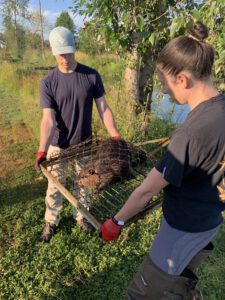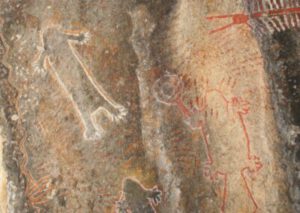Some time this spring, beavers will return to the ancestral lands of the Tule River Tribe in the Southern Sierra Nevada. It will be a moment tribal leaders have spent a decade preparing for, hoping the once thriving and now missing aquatic rodent can help return the forest’s natural drought resistance.
Beavers Create, Protect Wetlands

When European settlers first arrived in North America, some 100 to 200 million beavers lived in the lakes, rivers and streams here. But because their dams threatened agriculture and their pelts carried a high value, the North American beaver was hunted to near extinction. Ninety percent of the beaver population was wiped out.
The consequences of the kill-off linger to this day. Beaver dams naturally filter silt that otherwise clogs streams, while creating wetlands that preserve water on the land for longer periods. As beavers were wiped out, the waterways no longer reached ancient floodplains. This has led to increasing pollution and erosion, as well as more flooding and drought.
The need to fight effects of a drying climate on their land brought the Tule River Tribe to the forefront of the effort to restore California’s beaver population. Tribal leaders hope beavers can help reverse the ongoing degradation of the state’s mountain peaks, river valleys and mountain meadows.
“Tule River Tribe started this journey back in 2014,” said Kenneth McDarment, a member of the Tule River Tribal Council who’s been working with the California Department of Fish and Wildlife (CDFW) on its Beaver Restoration Program.
“The reason this started is we were in one of the worst droughts on record,” he said.
First ‘beaver translocation’ in 75 years
The CDFW program recently released the first beavers into new territory, into a valley in Plumas County, Tásmam Koyóm, on the land of the Yamonim Maidu. A family of seven beavers was moved south from Sutter County, where their dam-building was damaging habitat crucial to other rare and endangered species.
Because of the extensive preparation for the reintroduction of beavers, at least one local beaver was already calling Tásmam Koyóm home when the beaver family – a breeding pair and five of their offspring – were released. The family explored the area thoroughly, met their new neighbor and have settled in for the winter, the CDFW said.
CDFW Director Charlton H. Bonham gave much of the credit for the successful release – which the CDFW calls “beaver translocation activities” – to the leaders of the Tule River Tribe.
“Getting to this moment of our first reintroduction really is a product of so much leadership from so many people,” he said. “We would not be here without the Tule River Tribe of California who have been out front advocating for these actions for years, tribes around the state like Karuk, and, of course, Maidu Summit Consortium leaders. The future looks much better because of these leaders.”
Beavers Key in Local Tribal Tradition

McDarment says beavers belong in the Southern Sierra, and the land is suffering in their absence. Restoring beavers to their natural range may help reverse the loss of balance.
“We’re revitalizing the waterways by bringing the beavers home,” he said. “Beavers and waterways go hand in hand.”
The evidence of the beavers’ former presence in Tulare County’s mountains is still part of the ancient landscape.
“Our pictographs, when you look at them, there are beavers,” McDarment said. “We thought, why not let the beavers do what they do naturally?”
And it’s part of the tribe’s cultural heritage. The beaver was one of four animals that swam to the bottom of the sea when the world was covered in water. The sand the animals brought up became the land. Beavers helped create the world.
“Beaver relocation will help both to restore the environment and preserve traditional culture of our tribal partners who have stewarded these lands since time immemorial,” said California Natural Resource Agency Secretary Wade Crowfoot who attended the beaver release in Plumas County. “I’m excited to watch how beavers will improve the health of landscapes in coming decades and support traditional lifeways for our diverse tribal communities.”
Tule River Tribe Preparing for Beaver Homecoming
Beavers remain on the Tule River lands these days only in legend.
“The stories are there,” McDarment said. “The elders talk about the beavers.”
But there are those, like Tule River Tribal Council member Vernon Verra, who remember when beavers still lived on the tribe’s land.
“He showed us locations on the reservation that had beaver when he was a kid,” McDarment said. “Right now we have no beavers on the reservation. Talking with the elders, (beavers disappeared) anywhere up to 60 years back.”
The beaver habitat remains, but not the animal.
“The elders say they were here. Over the years we don’t see them no more,” McDarment said. “We do have a lot of waterways in the South Tule Water Drainage but they (beavers) haven’t been seen no more.”
McDarment said the tribal council has been restoring parts of their land for the beavers’ return. Beavers will need adequate protection from predators and room for the population to establish and expand.
“The reservation has been doing remediation for a few years,” he said. “We’ve been doing that in preparation of receiving beavers one day.”
